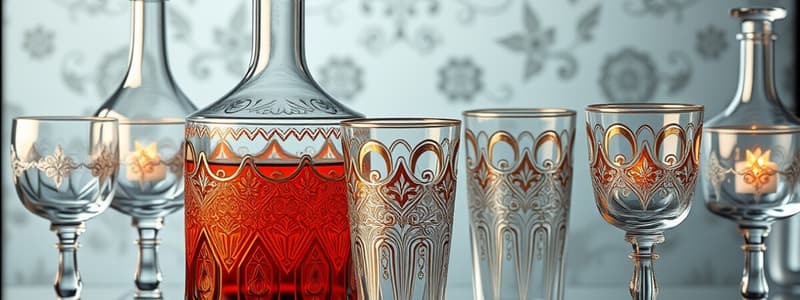Podcast
Questions and Answers
What is the primary purpose of greasing ground glass joints in lab apparatus?
What is the primary purpose of greasing ground glass joints in lab apparatus?
- To enhance the aesthetic appeal of the apparatus
- To prevent chemical interaction and ensure functionality (correct)
- To reduce friction between moving parts
- To maintain a constant temperature in the apparatus
Which of the following is an appropriate method for applying grease to ground glass joints?
Which of the following is an appropriate method for applying grease to ground glass joints?
- Incorporating grease into the joint material before usage
- Using a thin streak of grease applied sparingly (correct)
- Applying large amounts of grease to create a thick layer
- Soaking the joint in grease before assembly
Which scenarios would NOT require the use of grease on ground glass joints?
Which scenarios would NOT require the use of grease on ground glass joints?
- Setting up a vacuum system
- Working with strong bases
- Heating above 150 degrees Celsius
- Using the apparatus at room temperature (correct)
What could happen if too much grease is applied to a ground glass joint?
What could happen if too much grease is applied to a ground glass joint?
What is the most commonly used type of grease for ground glass joints?
What is the most commonly used type of grease for ground glass joints?
What is the primary reason for using a condenser during the refluxing process?
What is the primary reason for using a condenser during the refluxing process?
Which type of condenser is recommended for reactions that require heating above 150°C?
Which type of condenser is recommended for reactions that require heating above 150°C?
What should be avoided to prevent contamination of the sample during assembly?
What should be avoided to prevent contamination of the sample during assembly?
In the context of anhydrous chemical reactions, what is the role of a drying tube?
In the context of anhydrous chemical reactions, what is the role of a drying tube?
Which type of flask allows for the addition of reagents during a reflux reaction using a Claisen adapter?
Which type of flask allows for the addition of reagents during a reflux reaction using a Claisen adapter?
What does the symbol representing Standard Taper Glassware indicate about its construction?
What does the symbol representing Standard Taper Glassware indicate about its construction?
In which scenario is it especially important to use grease on ground glass joints?
In which scenario is it especially important to use grease on ground glass joints?
What is a major advantage of using standard taper joints compared to older glassware methods?
What is a major advantage of using standard taper joints compared to older glassware methods?
What effect does applying too much grease to a ground glass joint have?
What effect does applying too much grease to a ground glass joint have?
What is the purpose of using a hydrocarbon grease like Lubriseal specifically in laboratory settings?
What is the purpose of using a hydrocarbon grease like Lubriseal specifically in laboratory settings?
Flashcards are hidden until you start studying
Study Notes
Standard Taper Glassware
- Identified by the symbol 19/22, indicating specific dimensions for fittings.
Ground Glass Joints
-
Greasing Purpose:
- Prevents chemical reactions between joints.
- Stops joints from freezing together during use.
-
Preferred Grease:
- Lubriseal, a hydrocarbon-based grease, is favored for its ease of removal and common usage in laboratories.
-
Application Guidelines:
- Apply grease sparingly to avoid excess.
- Use thin streaks on the top of the joint for effective sealing.
- Sequence: Seat the joint, apply grease, then secure with a clamp.
- Properly applied grease should be transparent.
-
Cautions:
- Excessive grease is detrimental; it can dissolve in solvents, leading to sample contamination.
-
Appropriate Use Cases for Greasing:
- Ideal for vacuum setups to maintain airtight seals.
- Recommended for environments involving strong bases.
- Necessary for processes involving heating above 150 degrees Celsius.
- Useful in systems requiring rotation to prevent seizing of parts.
Laboratory Glassware
- Standard Taper Glassware features ground glass joints for a tight, interchangeable fit.
- The symbol for this glassware is a capital T overlaid on a capital S, representing “Standard Taper,” followed by a specific size designation (e.g., 19/22).
- The first number indicates the outer diameter (OD) in mm, while the second number denotes the ground glass joint length in mm.
- Ground glass joints facilitate the rapid assembly of apparatus like round bottom flasks and condensers, improving efficiency compared to custom-made glassware or cork/rubber bungs.
Greasing Ground Glass Joints
- Ground glass joints should be lubricated with grease to prevent reactions with chemicals and avoid "freezing" during assembly.
- Grease is essential for vacuum setups, strong bases, reactions above 150°C, and joints requiring rotation.
- Lubriseal, a hydrocarbon grease, is commonly used due to its easy removal properties.
- Apply the grease sparingly to the top half of the male joint and rotate gently to ensure a proper seal.
- Excess grease can contaminate samples if it spreads into the apparatus.
Reaction Assembly
- Preventing the loss of volatile components is critical during organic reactions through various techniques.
- Refluxing allows for prolonged heating without losing reagents; vapors condense back into the mixture using a condenser.
- Water-cooled condensers are suitable for reactions below 150°C, while air-cooling condensers are for higher temperatures.
Techniques for Specific Situations
- Dry Reflux: Use a drying tube with anhydrous CaCl2 to guard against atmospheric moisture entering the reaction vessel.
- Reagent Addition: In single neck round bottom flasks, a Claisen adapter or a three-neck flask can facilitate the addition of reagents during reflux.
- Removal of Noxious Gases: Built mechanisms must be in place to capture harmful gases like SO2, NO2, or HCl(g) to maintain laboratory safety.
Studying That Suits You
Use AI to generate personalized quizzes and flashcards to suit your learning preferences.




